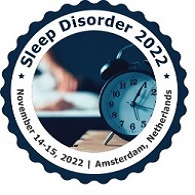
Natasha Ivanova
Institute of Neurobiology, Bulgarian Academy of Sciences (BAS), Bulgaria
Title: Novel Insights To Sleep Disorders
Biography
Biography: Natasha Ivanova
Abstract
The prenatal stress (PNS) in rodents appears to impair the circadian rhythm of sleep/wake cycle. The novel compound Piromelatine (Pir), a mixed melatonin type 1 and 2 and serotonin (5-HT) 1A/1D receptor agonist and 5-HT2B receptor antagonist, is designed for the treatment of insomnia. With this study we explored the effects of Pir on the altered motor activity, sleep architecture and circadian rhythmicity of sleep/wake cycle in prenatally stressed male and female offspring rats. Adult female Sprague–Dawley rats were exposed to different types of stressor from day 7 until birth and adult male and female offspring were explored. Piromelatine was administered at a dose of 20 mg/kg/day for the period of 7 days on 60-day old male and female offspring. Electroencephalographic (EEG), electromyographic (EMG) and home cage motor activity recordings were done for up to 24 h and were analyzed under basal conditions (12:12 LD cycle+vehicle), groups: C-veh, C-Pir, C-Pir- Luzinodol (Luz), PNS+vehicle, PNS+Pir and PNS+Pir+Luz (10 mg/kg) conditions. The PNS exposure impaired the home cage locomotion and sleep/wake cycle indicated by increased motor activity, decreased NREM sleep, elevated REM sleep and wake pattern in both male and female offspring in a sex-dependent manner. Chronic Pir treatment improved the PNS-impaired locomotion, sleep architecture and sleep-wake cycle, while this effect was suppressed by the melatonin receptor antagonist Luz. Current findings suggest that that the novel melatoninergic drug Pir is able to exert sex-dependent beneficial effects on PNS-induced alteration of home cage motor activity, rhythmicity of sleep/wake cycle and sleep architecture.

